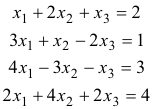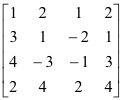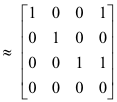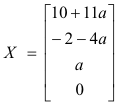
Website owner: James Miller
Systems of linear equations. Matrix solution, augmented matrix, homogeneous and non-homogeneous systems, Cramer’s rule, null space
Matrix form of a linear system of equations. The matrix form of a system of m linear equations in n unknowns

is

![]()

or, more concisely,
AX = B
where A is the coefficient matrix,

and
 .
.
Augmented matrix of a system of linear equations. The augmented matrix of a system of linear equations AX = B is the matrix

formed by appending the constant vector (b’s) to the right of the coefficient matrix.
Solving a system of linear equations by reducing the augmented matrix of the system to row canonical form. A system of linear equations AX = B can be solved by reducing the augmented matrix of the system to row canonical form by elementary row operations.
Example. Solve the system

The augmented matrix is

[A B] is reduced by elementary row transformations to row equivalent canonical form as follows:





Thus the solution is the equivalent system of equations:

Expressed in vector form, we have

Basic Theorems
How does one know if a system of m linear equations in n unknowns is consistent or inconsistent i.e. if it has a solution or not? The answer is given by the following fundamental theorem.
Fundamental theorem. A system AX = B of m linear equations in n unknowns is consistent if and only if the coefficient matrix and the augmented matrix of the system have the same rank.
Corollary. A necessary condition for the system AX = B of n + 1 linear equations in n unknowns to have a solution is that |A B| = 0 i.e. the determinant of the augmented matrix equals zero.
Theorem. In a consistent system AX = B of m linear equations in n unknowns of rank r < n, n-r of the unknowns may be chosen so that the coefficient matrix of the remaining r unknowns is of rank r. When these n-r unknowns are assigned any whatever values, the other r unknowns are uniquely determined.
Example. In the system

the augmented matrix is

We reduce [A B] by elementary row transformations to row equivalent canonical form [C K] as follows:




Since A and [A B] are each of rank r = 3, the given system is consistent; moreover, the general solution contains n - r = 4 - 3 = 1 arbitrary constant. From the last row of [C K], x4 = 0. Let x3 = a where a is arbitrary; then x1 = 10 + 11a and x2 = -2 - 4a. The solution of the system is given by x1 = 10 + 11a , x2 = -2 - 4a , x3 = a, x4 = 0 or

Homogeneous and non-homogeneous systems. A linear equation of the type
a1x1 + a2x2 + .... + anxn = 0
in which the constant term is zero is called homogeneous whereas a linear equation of the type
a1x1 + a2x2 + .... + anxn = b
where the constant term b is not zero is called non-homogeneous. Similarly a system of equations AX = 0 is called homogeneous and a system AX = B is called non-homogeneous provided B is not the zero vector.
Theorem. A system of n non-homogeneous equations in n unknowns AX = B has a unique solution provided the rank of its coefficient matrix A is n, that is provided |A| ≠0.
Two additional methods for solving a consistent non-homogeneous system AX = B of n equations in n unknowns.
Method of determinants using Cramers’s Rule. Denote by Ai, (i = 1,2, ..., n) the matrix obtained from A by replacing its i-th column with the column of constants (the b’s). Then, if |A| ≠0, the system AX = B has the unique solution

Solution using A-1 . If |A| ≠ 0 , A-1 exists and the solution of the system AX = B is given by X = A-1 B.
Theorem. In a system of n linear equations in n unknowns AX = B, if the determinant of the coefficient matrix A is zero, no solution can exist unless all the determinants which appear in the numerators in Cramer’s Rule are also zero.
Homogeneous systems of equations.
Consider the homogeneous system of linear equations AX = 0 consisting of m equations in n unknowns. Let the rank of the coefficient matrix A be r. If r = n the solution consists of only the single solution X = 0, which is called the trivial solution. If r < n there are an infinite number of solution vectors which will satisfy the system corresponding to all points in some subspace of n-dimensional space. To illustrate this let us consider some simple examples from ordinary three-dimensional space.
Suppose the system AX = 0 consists of the single equation
5x + 3y + 9z = 0
This equation corresponds to a plane in three-dimensional space that passes through the origin of the coordinate system. Any point on this plane satisfies the equation and is thus a solution to our system AX = 0. The set of all solutions to our system AX = 0 corresponds to all points on this plane. Furthermore, since the plane passes through the origin of the coordinate system, the plane represents a vector space. Why? Because a linear combination of any two vectors in the plane is also in the plane and any vector in the plane can be obtained as a linear combination of any two basis vectors in the plane. So, in summary, in this particular example the solution set to our system AX = 0 corresponds to the two-dimensional subspace of three-dimensional space represented by this plane. We call this subspace the solution space of the system AX = 0.
Let us consider another example. Suppose the system AX = 0 consists of the following two equations
2x + 5y + 3z = 0
9x - 2y - 8z = 0
These two equations correspond to two planes in three-dimensional space that intersect in some line which passes through the origin of the coordinate system. Any point of this line of intersection satisfies the system and is thus a solution to our system AX = 0. Furthermore, since the line passes through the origin of the coordinate system, the line represents a vector space. A linear combination of any two vectors in the line is also in the line and any vector in the line can be obtained as a linear combination of any basis vector for the line. So, in summary, in this example the solution set to our system AX = 0 corresponds to a one-dimensional subspace of three-dimensional space represented by this line of intersection of the two planes. In this case the solution space of the system AX = 0 is one-dimensional.
What determines the dimension of the solution space of the system AX = 0? The dimension is given by n - r. In our first example the number of unknowns, n, is 3 and the rank, r, is 1 so the dimension of the solution space was 3 - 1 = 2. In our second example n = 3 and r = 2 so the dimension of the solution space was 3 - 2 = 1.
Null space of a matrix. The solution space of the homogeneous system AX = 0 is called the null space of matrix A. The reason for this name is that if matrix A is viewed as a linear operator that maps points of some vector space V into itself, it can be viewed as mapping all the elements of this solution space of AX = 0 into the null element "0". Thus the null space N of A is that subspace of all vectors in V which are imaged into the null element “0" by the matrix A.
Nullity of a matrix. The nullity of a matrix A is the dimension of the null space of A.
If matrix A has nullity s, then AX = 0 has s linearly independent solutions X1, X2, ... ,Xs such that every solution of AX = 0 is a linear combination of them and every linear combination of them is a solution. A basis for the null space A is any set of s linearly independent solutions of AX = 0. The nullity of an mxn matrix A of rank r is given by
s = n - r .
Theorem 1. A necessary and sufficient condition for the system AX = 0 to have a solution other than the trivial solution is that the rank of A be r < n.
Theorem 2. A necessary and sufficient condition that a system AX = 0 of n homogeneous equations in unknowns have a solution other than the trivial solution is |A| = 0.
Theorem 3. If the rank of AX = 0 is r < n, the system has exactly n-r linearly independent solutions such that every solution is a linear combination of these n-r linearly independent solutions and every such linear combination is a solution.
Complete solution of the homogeneous system AX = 0.
The complete solution of the linear system AX = 0 of m equations in n unknowns consists of the null space of A which can be given as all linear combinations of any set of linearly independent vectors which spans this null space. If the rank of A is r, there will be n-r linearly independent vectors u1, u2, ... , un-r that span the null space of A. Thus the complete solution can be written as
X = c1u1 + c2u2 + .... + cn-run-r
where c1, c2, ... , cn-r are arbitrary constants.
Complete solution of the non-homogeneous system AX = B.
If the system AX = B of m equations in n unknowns is consistent, a complete solution of the system is given by the complete solution of AX = 0 plus any particular solution of AX = B. The complete solution of AX = 0 consists of the null space of A which can be given as all linear combinations of any set of linearly independent vectors which spans this null space. If the rank of A is r, there will be n-r linearly independent vectors u1, u2, ... , un-r that span the null space of A. If we denote a particular solution of AX = B by xp then the complete solution can be written as
X = xp + c1u1 + c2u2 + .... + cn-run-r
where c1, c2, ... , cn-r are arbitrary constants.
References.
Ayres. Matrix Theory.
Jesus Christ and His Teachings
Way of enlightenment, wisdom, and understanding
America, a corrupt, depraved, shameless country
On integrity and the lack of it
The test of a person's Christianity is what he is
Ninety five percent of the problems that most people have come from personal foolishness
Liberalism, socialism and the modern welfare state
The desire to harm, a motivation for conduct
On Self-sufficient Country Living, Homesteading
Topically Arranged Proverbs, Precepts, Quotations. Common Sayings. Poor Richard's Almanac.
Theory on the Formation of Character
People are like radio tuners --- they pick out and listen to one wavelength and ignore the rest
Cause of Character Traits --- According to Aristotle
We are what we eat --- living under the discipline of a diet
Avoiding problems and trouble in life
Role of habit in formation of character
Personal attributes of the true Christian
What determines a person's character?
Love of God and love of virtue are closely united
Intellectual disparities among people and the power in good habits
Tools of Satan. Tactics and Tricks used by the Devil.
The Natural Way -- The Unnatural Way
Wisdom, Reason and Virtue are closely related
Knowledge is one thing, wisdom is another
My views on Christianity in America
The most important thing in life is understanding
We are all examples --- for good or for bad
Television --- spiritual poison
The Prime Mover that decides "What We Are"
Where do our outlooks, attitudes and values come from?
Sin is serious business. The punishment for it is real. Hell is real.
Self-imposed discipline and regimentation
Achieving happiness in life --- a matter of the right strategies
Self-control, self-restraint, self-discipline basic to so much in life